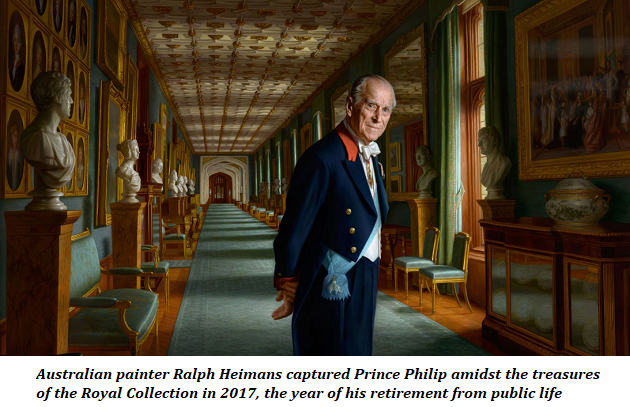
Among the many tributes paid to the late Prince Philip, Duke of Edinburgh KG AK, there was mention of the fact that he had visited the Commonwealth of Australia on some 21 occasions, including as a Royal Navy Officer prior to his marriage in 1947 to Princess Elizabeth Alexandra Mary, who became Her Majesty Queen Elizabeth II upon the demise of King George VI in 1952. One aspect of the late Prince Philip’s life which has been less noticed, given his naval career and prodigious public service to the United Kingdom and to the Commonwealth of Nations as Consort of the Queen, was his interest in the art of painting and his patronage of significant artists, including several Australian artists.
The Prince’s contributions to the building up of the Royal Collections and the Royal Heritage during the Queen’s reign have been very important, especially in the significant effect that his taste had in bringing major artistic talents to greater public notice. His friendship with and encouragement of the splendidly accomplished, yet critically neglected, British painter of landscapes Edward Seago is well known. Seago (three of whose works are reproduced below) also tutored the Prince in the practical arts of painting.

Less well known, in Australia at least, was the Prince’s appreciation and fostering of the distinctive work of the brilliant Polish immigrant artist Feliks Topolski RA, who came to Britain in the 1930s. Some of the major Australian artists whose works were encouraged and purchased or were commissioned by the Prince, were firstly Albert Namatjira, then Sir Sidney Nolan, Sir William Dobell and Sir Russell Drysdale, amongst various others.
This essay outlines the support which Prince Philip gave to painters and their art. It was an important aspect of his life, and given his many other qualities now serves to underscore how even the most vigorous and, indeed, martial of personalities can often have an appreciation of and an alertness in the presence of artworks executed by painters of talent, but for which such persons are given scant credit by most of their contemporaries. As in so many other fields, the interest taken by the Prince in painting and painters was important against a background of the mid-twentieth century, when in certain quarters of what in the 1950s became known as “The Establishment”, an interest in painting, or indeed in any of the arts, was often made out to be something deeply suspect. To take another example drawn from the Royal Family, that is demonstrated by what the Queen’s cousin, the late Lord Harewood, a leading world authority on the opera and the art of song, reported in his autobiography The Tongs and the Bones about conventional attitudes to any interest in the arts. It seems King Edward VIII had once muttered words to the effect “Yes, we don’t quite know what it is about George and his interest in music: his parents are really quite normal you know, they like dogs and horses and country things in general.”
Likewise, it is perhaps little known that the talents of George VI, King-Emperor and Commander in Chief in World War II, also extended to the practical art and skill of embroidering sturdy chair coverings, still to be seen at Windsor Castle. The Seventh Earl Spencer, grandfather of Princess Diana, was similarly skilled and deeply involved with the upkeep of his inheritance at Althorp. Prince Philip came of a major European Royal House and his patronage of the arts is perhaps another echo of the like role of the late Queen Mary, who in her youth had lived in Florence and having there imbibed a deep appreciation of art and things of beauty, rarity and distinction, carried that interest into her life in the United Kingdom. From 1917, she and King George V stabilised a Monarchy recast as the House of Windsor, at a time when others had disappeared or were deposed and either lost or had to sell, their great art and objects collections. Prince Philip followed the earlier example of Prince Albert in his encouragement of better industrial design and architecture, and also of painters and sculptors. Thus he was at a far remove from the days of the Hanoverian George II, who had once famously said, in his strong German accent: “I hate all Boets and Bainters!”.
Many will have noticed over the years that in addition to published writings of his own, Prince Philip had frequently contributed forewords to various publications, including books upon various artists. It is from these that we can glean some clearer idea of his encouragement and patronage of the art and skill of painting by numerous artists in the United Kingdom and Commonwealth countries, including Australia, who were to become eminent in their careers. For example, the Prince wrote the following in his Foreword to James Reid’s Edward Seago: The Landscape Art (Sotheby’s, 1991):
I cannot be objective about Edward Seago’s painting. He was a frequent visitor to Sandringham and I used to call on him at his home in Norfolk. We became firm friends and that is why I invited him to join me in the Royal Yacht Britannia for the return journey from the Olympic Games in Melbourne at the end of 1956. The plan was to cross the South Pacific to the Grahamland Peninsula and to see something of the work of what was then known as the Falkland Islands Dependencies Survey. This has since changed its name to the British Antarctic Survey.
I had no idea of what to expect, but I knew that no artist of any repute had done any work in the Antarctic since Wilson did his marvellous watercolours while he was with the Scott Expedition. I hoped that Ted would find something to challenge his remarkable talent for landscape painting. Neither of us was disappointed. We could hardly tear him away from his easel to come to meals. He was fascinated by the icebergs, the colour of the sea between the drifting pack-ice and the background of glaciers and snow-covered hills. He went on painting as we called at South Georgia, the Falklands, Gough Island, Tristan da Cunha, St Helena, Ascension Island and the Gambia. The novelty of the light and landscape of these unfamiliar places fascinated him and the rest of us were fascinated by his almost miraculous technique. He had a knack of capturing a scene with a speed and dexterity that rivalled that of a conjuror.
The Prince took some lessons from Seago and the outcome were some paintings which were later mentioned and illustrated in a 1981 BBC book on the Royal Heritage. It is notable that the Prince in his foreword to Reid’s book on Seago makes no mention of his own efforts at painting under the artist’s kind tutelage. Such modesty in the face of major painterly expertise was part of the Prince’s trademark reticence and courtesy, notwithstanding other ebullient moments. I am informed that on his visits to Australia, Prince Philip was always delighted not only to discuss Seago’s work, but those of major Australian artists as well.
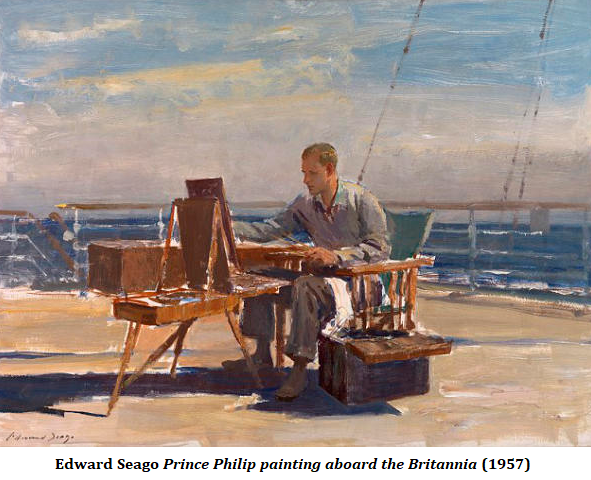
Later on, landscape works by Edward Seago entered the Royal Collection. Some examples are featured in Plumb and Wheldon’s book: Antarctic Scene and The John Biscoe in the Antarctic (1956-57), Evening on the Hard, Pin Mill and West African Market, Selikini and Buckingham Palace from St James’ Park. In addition, as a result of their friendship over the years, various other works by Seago were acquired by the Prince personally for his private collection. This princely and friendly patronage was important for Edward Seago, who indeed had major talents and high skill as a painter, but was routinely disregarded by the bienpensants amongst the British art critics’ “Establishment”. Plumb and Wheldon note that whilst the Royal Collections in the twentieth century gained works by most of the leading British contemporary artists, such as the two Nashes, Lowry, Graham Sutherland, Ivon Hitchens, Darwin, Rowntree, Armstrong, de Grey and Davie
It is impossible to leave the story of the acquisition of paintings [for the Royal Collections] without saying far more of the patronage of Edward Seago that rapidly ripened into friendship with three generations of the Royal Family. Seago had acquired a huge popular reputation in the years immediately after the War – queues formed outside Colnaghi’s in Bond Street on the opening of an exhibition and people scrambled in to buy. The Royal Academy, however, ignored him: so did the critics. He painted both in oils and watercolour, both portraits and landscapes. He could catch a quick likeness with a touch of de Laszlo’s panache, but landscape was his primary interest. He was extremely sympathetic to the wind-driven skies and the shimmering marshes of Norfolk. His brush was very facile, his colours pure and mysteriously life-enhancing. He was light 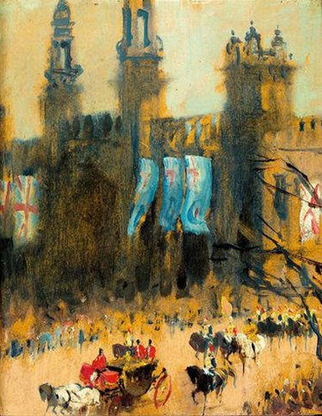 years away from all that was fashionable with the world of art or of Bloomsbury. He was, however, securely locked in the tradition of the great East Anglian painters, a true descendant of old Crome and Constable who are now revered.
years away from all that was fashionable with the world of art or of Bloomsbury. He was, however, securely locked in the tradition of the great East Anglian painters, a true descendant of old Crome and Constable who are now revered.
In the Forties, he painted a lively portrait of King George VI and did three impressionistic studies of the wedding procession of Princess Elizabeth and Lieutenant Mountbatten (one of which is reproduced at left). By then he was in high favour will all the members of the Royal Family and Queen Elizabeth (later the Queen Mother) invited him to Sandringham in January 1950. For the next twenty-two years he visited Sandringham regularly both in winter and summer and the Royal Family acquired numerous dazzling Seagos. And then, in 1956, Prince Philip invited Seago to accompany him to the Antarctic aboard the Britannia [and] during the voyage he gave lessons to the Prince in watercolour painting and produced a series of fascinating Antarctic landscapes that are now part of the Royal Collections. … Seago remains the only artist of quality to have painted these strange lunar landscapes of the far South. Later he gave lessons to the Prince of Wales. Both father and son greatly admired his skill and creative energy and they loved his pictures. This royal support was extremely important to Seago who was a deeply insecure man, wounded by the neglect and hostility not only of art critics but also of the artistic establishment as represented by the Royal Academy. As well as strengthening his confidence, the royal patronage also gave him the opportunity to paint landscapes of countries he would never have seen or visited. One can argue that Seago was not in the class of Sutherland, or Bacon or Hitchens and many other painters of deeper creative talent, but he was thoroughly accomplished in a deeply English tradition and his work will be remembered long after the brick arrangers, the minimalists and the rest are forgotten. His talents were fostered by Queen Mary, by Queen Elizabeth the Queen Mother and by Prince Philip, and it was patronage well placed.”
Another example of a major artistic talent encouraged and assisted by Prince Philip whilst accorded only the belated recognition of the British Art Establishment, was Feliks Topolski (1907-1989). He came to London in 1935 and was an Official War Artist for both the British Government and the Polish Government in Exile, from 1940 to 1945. After
witnessing sea encounters in a cruiser on patrol duty in the Arctic, of the campaign against the Japanese in Burma and of China’s endurance, Topolski rolled up Italy with the Polish 2nd Corps and went with the Allied advance into Germany. He followed on the heels of the troops who entered the death camp of Belsen; and ultimately in 1946, he would attend the trials of Nazi war criminals at Nuremberg.
Afterwards, he produced a remarkable body of work in paintings and drawings. He possessed a very distinctive drawing style, developed to a high degree during the 1930s in Paris, as shown in a special collection of his work done in France prior to 1939 but misplaced during the war and which ultimately was re-discovered and published in 1963. He gained wide notoriety in Britain at the end of the 1950s and early 1960s when he was commissioned by the BBC to do on-set drawings of most of the subjects being interviewed by John Freeman MBE for his Face to Face television series. These subjects included Evelyn Waugh, Dame Edith Sitwell, Sir Herbert Read, Arnold Wesker and William Empson, amongst many other prominent personalities such as W.H. Auden, Ivy Compton-Burnett, Sir Compton Mackenzie, Cecil Day-Lewis and Stephen Spender. Prince Philip acquired many of these sketches by Topolski, which now hang in a corridor in the Private Apartments at Windsor Castle. Plumb and Wheldon comment that
They are full of insight into the character of the sitter[s] as revealing indeed as the interviews themselves … …There is a marvellously arrogant Edith Sitwell, an almost too avuncular J.B. Priestley and a brilliant Lord Hailsham, amongst others. They are extremely vivid images of the outstanding men and women of the 1940s and 1950s …. [and] because the Prince found these drawings so striking, he commissioned Topolski to paint the Coronation Procession. This again was very much in the royal tradition, for George IV had his procession painted in a huge book, one of the largest books ever made and opulent with gold leaf. Before this, there had been prints of the Hanoverian and Stuart Coronation Processions. Topolski’s painting now takes up a very long wall in a corridor in Buckingham Palace. It is vivid, lively, somewhat jumbled in the Topolski manner … and in some mysterious way it is dominated by the figure of Winston Churchill. In 1953, his prestige was vast and all eyes watched him as he moved slowly up the aisle at Westminster Abbey on that June morning. With his years of experience … he can only have been a daunting mentor in spite of the Queen’s long years of training for her accession. Also, Churchill possessed an almost baroque veneration for the throne which cannot have made for ease. So perhaps this dominating presence in the Coronation Procession is just.
The work is in fact a panorama in oils, done by Topolski from Coronation drawings he originally made during 1953.
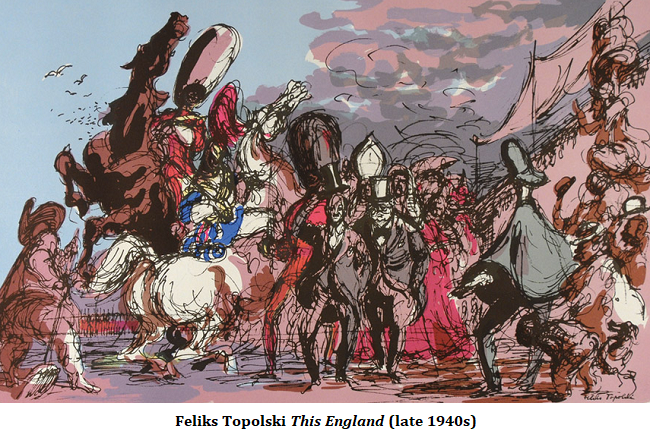
In his foreward to the magnificent book illustrating Topolski’s Buckingham Palace Panoramas (Quartet, 1977) Prince Philip wrote:
I came to admire and enjoy the work of Feliks Topolski during the War. He had already developed an unerring eye for the quirks of human nature which his vivid drawings translated into a gently satirical commentary on the social scene. Years later we met and I was both intrigued and stimulated by the originality and independence of his views.
The Prince acquired some of Topolski’s 1953 Coronation Drawings but later had the inspiration for a panorama by Topolski for Buckingham Palace. He wrote of this in 1977: “It is a fascinating contemporary record by a master of visual commentary of a great state occasion presented in his own highly individual idiom.” It is an enduring monument to Topolski and the Prince, who conceived the idea for this very important addition to the Royal Collections.
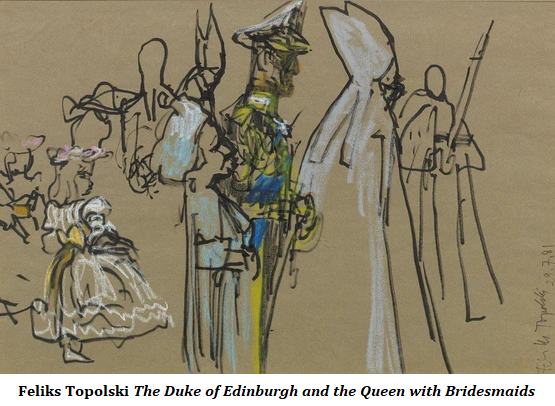
Turning now to the Australian artists who were encouraged and supported by the patronage of Prince Philip, chief amongst them were Albert Namatjira, Rex Batterbee, Sir Sidney Nolan, Sir William Dobell and Sir Russell Drysdale. Plumb and Wheldon’s 1981 book features Prince Philip at Windsor Castle in front of Drysdale’s Man in a Landscape and Dobell’s Country Race Meeting. They also illustrate watercolours by Namatjira and by Batterbee, noting that Prince Philip during his 1956 visit to Australia, in connection with the Olympic Games at Melbourne, went to Alice Springs where he bought a number of landscapes of Central Australian scenes by Aboriginal artists. In 1963, the Prince was again in Australia and acquired two watercolours by Rex Batterbee, who had originally encouraged and advised the Aboriginal artists of the Central Australian School and who benefitted greatly after royal purchases of their works.
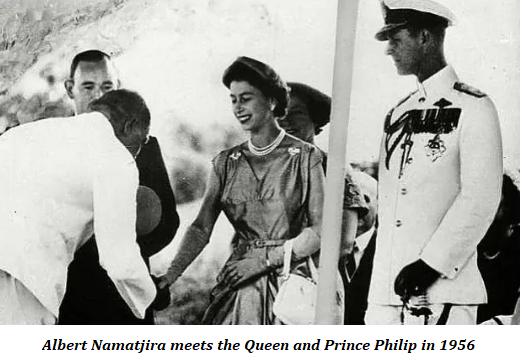 Sir Sidney Nolan was another Australian artist who was to enjoy the patronage of the Royal Family and the particular interest of Prince Philip. It may be here recalled that after visiting Australia in 1949 at the invitation of the National Gallery of Melbourne to advise on the building up of its collection and its presentation in a new building (which was to be completed in 1968) Sir Kenneth Clark, later Lord Clark of Civilisation fame, had developed a great enthusiasm for the work of Australian artists and, in particular, for the work of Sidney Nolan. In the 1950s, this interest in Australian art developed in London art circles and by 1955, Colin McInnes’ landmark article on Sidney Nolan and the Kelly Myth discussing Nolan’s “Ned Kelly” series of works had appeared in Encounter magazine. One major Nolan painting in the Royal Collection and illustrated in Plumb and Wheldon’s book is Herd at a Waterhole. Several other Nolans are included in the Royal Collection, including one entitled Strange Fruit. All of these are but examples, as Plumb and Wheldon note, that the Royal Collection is “particularly rich in works by Australian artists”. Prince Philip was a major impetus for this; since his interest in Australia, in its people and its art, deepened over the course of the more than 20 occasions when he visited and travelled throughout this country, which he obviously much appreciated.
Sir Sidney Nolan was another Australian artist who was to enjoy the patronage of the Royal Family and the particular interest of Prince Philip. It may be here recalled that after visiting Australia in 1949 at the invitation of the National Gallery of Melbourne to advise on the building up of its collection and its presentation in a new building (which was to be completed in 1968) Sir Kenneth Clark, later Lord Clark of Civilisation fame, had developed a great enthusiasm for the work of Australian artists and, in particular, for the work of Sidney Nolan. In the 1950s, this interest in Australian art developed in London art circles and by 1955, Colin McInnes’ landmark article on Sidney Nolan and the Kelly Myth discussing Nolan’s “Ned Kelly” series of works had appeared in Encounter magazine. One major Nolan painting in the Royal Collection and illustrated in Plumb and Wheldon’s book is Herd at a Waterhole. Several other Nolans are included in the Royal Collection, including one entitled Strange Fruit. All of these are but examples, as Plumb and Wheldon note, that the Royal Collection is “particularly rich in works by Australian artists”. Prince Philip was a major impetus for this; since his interest in Australia, in its people and its art, deepened over the course of the more than 20 occasions when he visited and travelled throughout this country, which he obviously much appreciated.
In his important and influential study, Patrons and Painters (1963, rev. ed. 1980) Francis Haskell has powerfully reminded us of the capital importance, over history, of the effect of the patronage of princes for the encouragement of art and artists, whether by princes of the Church or secular princes. The late Prince Philip and Duke of Edinburgh may not have amassed vast collections like those of King Charles I and of the Empress Catherine the Great of All the Russians, but in his own modest way and in a manner which assisted numerous artists to come into greater public prominence, he had augmented the Royal Collections of the Crown and also formed a quality private collection. And from the point of view of us in Australia, he not only had occasion to visit most if not all, of the major Australian State Public Galleries, but was also present supporting Her Majesty the Queen, when she graciously performed the formal opening of the National Gallery of Australia (at first named the “Australian National Gallery”, but later revised to the more conventional and practical format, reflecting the usual international gallery practice) at the National Capital Canberra in 1982. All of this is part of the enduring legacy of that man of many parts who was the Prince Philip, consort of the Queen and a patron of painting.
Dr Douglas Hassall, who lives in Melbourne, has been a contributor on art and other matters to Quadrant for many years
 Sign In
Sign In 0 Items (
0 Items ( Search
Search










Thanks for a very illuminating article. I had no idea.
Yes, the late Prince Philip, Duke of Edinburgh, worked tirelessly to promote talent in most/all fields of human endeavour.
Is there a non-White person, is there any Muslim, who has done more than the Duke of Edinburgh to assist the productivity of talented persons?
Meanwhile, all over the place, I see non-Whites and Whites, esp females, condemning Prince Philip.
Why?
The answers reside in the self-loathing, other-blaming, resentful psychology of such people.
These kinds of critics of extraordinarily contributory White males have a twisted animating motivation-
-they must demonise people who put in the effort to assist persons who could not fully flourish without some help.
For examples, see most feminists.
Start with Christine Holgate, as merely a current example.
Such females of limited ability, but with vast hunger for power, celebrity and money, abound.
And they are assisted by males of all colours-
-males who themselves lack the talents and the work ethic to help themselves and thereby to gain assistance by others who would help people of talent and positive work ethic and/or can pocket some dough by so doing.
Just love the Prince’s paintings